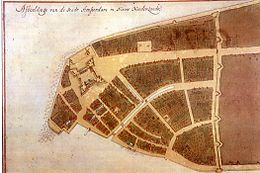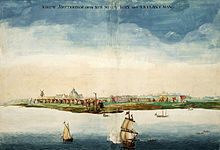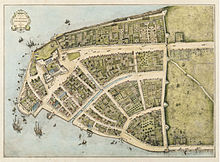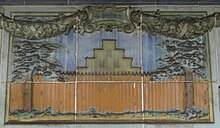The original city map of New Amsterdam, called the Castello Plan, from 1660 (the bottom left corner is approximately south, while the top right corner is approximately north)
New Amsterdam (Dutch: Nieuw Amsterdam, pronounced [ˌniʋɑmstərˈdɑm] or [ˌniuʔɑms-]) was a 17th-century Dutch settlement established at the southern tip of Manhattan Island that served as the seat of the colonial government in New Netherland. The factorij became a settlement outside Fort Amsterdam. The fort was situated on the strategic southern tip of the island of Manhattan and was meant to defend the fur trade operations of the Dutch West India Company in the North River (Hudson River). In 1624, it became a provincial extension of the Dutch Republic and was designated as the capital of the province in 1625.
By 1655, the population of New Netherland had grown to 2,000
people, with 1,500 living in New Amsterdam. By 1664, the population of
New Netherland had skyrocketed to almost 9,000 people, 2,500 of whom
lived in New Amsterdam, 1,000 lived near Fort Orange, and the remainder in other towns and villages.
In 1664 the English took over New Amsterdam and renamed it New York City after the Duke of York (later James II & VII). After the Second Anglo-Dutch War of 1665–67, England and the United Provinces of the Netherlands agreed to the status quo in the Treaty of Breda.
The English kept the island of Manhattan, the Dutch giving up their
claim to the town and the rest of the colony, while the English formally
abandoned Surinam in South America, and the island of Run in the East Indies to the Dutch, confirming their control of the valuable Spice Islands. Today much of what was once New Amsterdam is in New York City.
History
Early settlement (1609–1625)
The
Rigging House at 120 William Street, the last remaining Dutch building
of New Amsterdam. Built in the 17th century, it became a Methodist
church in the 1760s and became a secular building again before its
destruction in the mid-19th century.
In 1524, nearly a century before the arrival of the Dutch, the site that later became New Amsterdam was named New Angoulême by the Italian explorer Giovanni da Verrazzano, to commemorate his patron King Francis I of France, former Count of Angoulême. The first recorded exploration by the Dutch of the area around what is now called New York Bay was in 1609 with the voyage of the ship Halve Maen (English: "Half Moon"), captained by Henry Hudson in the service of the Dutch Republic, as the emissary of Maurice of Nassau, Prince of Orange, Holland's stadholder. Hudson named the river the Mauritius River. He was covertly attempting to find the Northwest Passage for the Dutch East India Company. Instead, he brought back news about the possibility of exploitation of beaver by the Dutch who sent commercial, private missions to the area the following years.
At the time, beaver pelts were highly prized in Europe, because the fur could be felted to make waterproof hats. A by-product of the trade in beaver pelts was castoreum—the secretion of the animals' anal glands—which was used for its medicinal properties and for perfumes. The expeditions by Adriaen Block and Hendrick Christiaensen in 1611, 1612, 1613 and 1614, resulted in the surveying and charting of the region from the 38th parallel to the 45th parallel. On their 1614 map, which gave them a four-year trade monopoly under a patent of the States General,
they named the newly discovered and mapped territory New Netherland for
the first time. It also showed the first year-round trading presence in
New Netherland, Fort Nassau, which would be replaced in 1624 by Fort Orange, which eventually grew into the town of Beverwijck, now Albany.
Dominican trader Juan Rodriguez (rendered in Dutch as Jan Rodrigues), born in Santo Domingo of Portuguese and African
descent, arrived on Manhattan Island during the winter of 1613–1614,
trapping for pelts and trading with the local population as a
representative of the Dutch. He was the first recorded non-Native
American inhabitant of what would eventually become New York City.
The territory of New Netherland was originally a private,
profit-making commercial enterprise focused on cementing alliances and
conducting trade with the diverse Native American ethnic groups.
Surveying and exploration of the region was conducted as a prelude to an
anticipated official settlement by the Dutch Republic, which occurred
in 1624.
Pilgrims' attempt to settle in the Hudson River area
In 1620 the Pilgrims attempted to sail to the Hudson River from England. However, Mayflower reached Cape Cod (now part of Massachusetts) on November 9, 1620, after a voyage of 64 days. For a variety of reasons, primarily a shortage of supplies, Mayflower could not proceed to the Hudson River, and the colonists decided to settle near Cape Cod, establishing the Plymouth Colony.
Dutch return
The mouth of the Hudson River
was selected as the ideal place for initial settlement as it had easy
access to the ocean while also securing an ice-free lifeline to the beaver trading post near present-day Albany. Here, Native American hunters supplied them with pelts in exchange for European-made trade goods and wampum, which was soon being made by the Dutch on Long Island. In 1621, the Dutch West India Company
was founded. Between 1621 and 1623, orders were given to the private,
commercial traders to vacate the territory, thus opening up the
territory to Dutch settlers and company traders. It also allowed the
laws and ordinances of the states of Holland to apply. Previously,
during the private, commercial period, only the law of the ship had
applied.
In May 1624, the first settlers in New Netherland arrived on Noten Eylandt (Nut or Nutten Island, now Governors Island) aboard the ship New Netherland under the command of Cornelius Jacobsen May, who disembarked on the island with thirty families to take legal possession of the New Netherland territory. The families were then dispersed to Fort Wilhelmus on Verhulsten Island (Burlington Island) in the South River (now the Delaware River), to Kievitshoek (now Old Saybrook, Connecticut) at the mouth of the Verse River (now the Connecticut River) and further north at Fort Nassau on the Mauritius or North River (now the Hudson River), near what is now Albany.
A fort and sawmill were soon erected at Nut Island. The latter was constructed by Franchoys Fezard and was taken apart for iron in 1648.
Fort Amsterdam (1624)
1626 letter in Dutch by Pieter Schaghen stating the purchase of Manhattan for 60 guilders.
A map of the Hudson River Valley c. 1635 (north is to the right)
The threat of attack from other European colonial powers prompted the directors of the Dutch West India Company
to formulate a plan to protect the entrance to the Hudson River. In
1624, 30 families were sponsored by Dutch West India Company moving from
Nut Island to Manhattan Island, where a citadel to contain Fort Amsterdam was being laid out by Cryn Frederickz van Lobbrecht at the direction of Willem Verhulst. By the end of 1625, the site had been staked out directly south of Bowling Green on the site of the present U.S. Custom House. The Mohawk-Mahican War
in the Hudson Valley led the company to relocate even more settlers to
the vicinity of the new Fort Amsterdam. In the end, colonizing was a
prohibitively expensive undertaking, only partly subsidized by the fur
trade. This led to a scaling back of the original plans. By 1628, a
smaller fort was constructed with walls containing a mixture of clay and
sand.
The fort also served as the center of trading activity. It
contained a barracks, the church, a house for the West India Company
director and a warehouse for the storage of company goods. Troops from the fort used the triangle between the Heerestraat and what came to be known as Whitehall Street for marching drills.
1624–1664
The First Slave Auction at New Amsterdam in 1655, by Howard Pyle
New Amsterdam in 1664 (looking approximately due north)
Verhulst, with his council, was responsible for the selection of
Manhattan as a permanent place of settlement and for situating Fort
Amsterdam. He was replaced as the company director-general of New
Amsterdam by Peter Minuit
in 1626. According to the writer Nathaniel Benchley, to legally
safeguard the settlers' investments, possessions and farms on Manhattan
island, Minuit negotiated the "purchase" of Manhattan from a band of Canarse from Brooklyn who occupied the bottom quarter of Manhattan, known then as the Manhattoes for 60 guilders'
worth of trade goods. Minuit conducted the transaction with the Canarse
chief Seyseys, who was only too happy to accept valuable merchandise in
exchange for an island that was actually mostly controlled by the Weckquaesgeeks.
The deed itself has not survived, so the specific details are unknown. A
textual reference to the deed became the foundation for the legend that
Minuit had purchased Manhattan from the Native Americans for
twenty-four dollars' worth of trinkets and beads, the guilder rate at
the time being about two and a half to a Spanish dollar. The price of 60 Dutch guilders in 1626 amounts to around $1,100 in 2012 dollars.
Further complicating the calculation is that the value of goods in the
area would have been different than the value of those same goods in the
developed market of the Netherlands.
The Dutch exploited the hydropower of existing creeks by
constructing mills at Turtle Bay (between present-day East 45th–48th
Streets) and Montagne's Kill, later called Harlem Mill Creek (East 108th
Street). In 1639 a sawmill was located in the northern forest at what
was later the corner of East 74th Street and Second Avenue, at which African laborers cut lumber.
The New Amsterdam settlement had a population of approximately 270 people, including infants. In 1642 the new director-general Willem Kieft
decided to build a stone church within the fort. The work was carried
out by recent English immigrants, the brothers John and Richard Ogden.
The church was finished in 1645 and stood until destroyed in the Slave Insurrection of 1741.
A pen-and-ink view of New Amsterdam, drawn on-the-spot and discovered in the map collection of the Austrian National Library
in Vienna in 1991, provides a unique view of New Amsterdam as it
appeared from Capske (small Cape) Rock in 1648. Capske Rock was situated
in the water close to Manhattan between Manhattan and Noten Eylant, and
signified the start of the East River roadstead.
New Amsterdam received municipal rights on February 2, 1653, thus becoming a city. Albany, then named Beverwyck, received its city rights in 1652. Nieuw Haarlem, now known as Harlem, was formally recognized in 1658.
The first Jews known to have lived in New Amsterdam arrived in
1654. First to arrive were Solomon Pietersen and Jacob Barsimson, who
sailed during the summer of 1654 directly from Holland, with passports
that gave them permission to trade in the colony. Then in early September, 23 Jewish refugees arrived from the formerly Dutch city of Recife, which had been conquered by the Portuguese in January 1654. The director of New Amsterdam, Peter Stuyvesant, sought to turn them away but was ultimately overruled by the directors of the Dutch West India Company in Amsterdam. Asser Levy, an Ashkenazi Jew
who was one of the 23 refugees, eventually prospered and in 1661 became
the first Jew to own a house in New Amsterdam, which also made him the
first Jew known to have owned a house anywhere in North America.
In 1661 the Communipaw ferry was founded and began a long history of trans-Hudson ferry and ultimately rail and road transportation. On September 15, 1655, New Amsterdam was attacked by 2,000 Native Americans as part of the Peach Tree War. They destroyed 28 farms, killed 100 settlers, and took 150 prisoners.
In 1664, Jan van Bonnel built a saw mill on East 74th Street
and the East River, where a 13,710-meter long stream that began in the
north of today's Central Park, which became known as the Saw Kill or Saw
Kill Creek, emptied into the river. Later owners of the property George Elphinstone and Abraham Shotwell replaced the sawmill with a leather mill in 1677. The Saw Kill was later redirected into a culvert, arched over, and its trickling little stream was called Arch Brook.
English capture
On
August 27, 1664, while England and the Dutch Republic were at peace,
four English frigates sailed into New Amsterdam's harbor and demanded
New Netherland's surrender, whereupon New Netherland was provisionally
ceded by Stuyvesant. On September 6, Stuyvesant sent lawyer Johannes de Decker and five other delegates to sign the official Articles of Capitulation. This was swiftly followed by the Second Anglo-Dutch War, between England and the Dutch Republic. In June 1665, New Amsterdam was reincorporated under English law as New York City, named after the Duke of York (later King James II). He was the brother of the English King Charles II, who had been granted the lands.
In 1667 the Treaty of Breda
ended the conflict in favor of the Dutch. The Dutch did not press their
claims on New Netherland but did demand control over the valuable sugar
plantations and factories captured by them that year on the coast of Surinam, giving them full control over the coast of what is now Guyana and Surinam.
In July 1673, during the Third Anglo-Dutch War, the Dutch briefly and quickly occupied New York City and renamed it New Orange. Anthony Colve was installed as the first governor. Previously there had only been West India Company directors. After the signing of the Treaty of Westminster in November 1674, the city was relinquished to the English and the name reverted to "New York". Suriname became an official Dutch possession in return.
Cartography
Redraft of the Castello Plan, drawn in 1916
The beginnings of New Amsterdam, unlike most other colonies in the New World, were thoroughly documented in city maps.
During the time of New Netherland's colonization, the Dutch were the
pre-eminent cartographers in Europe. The delegated authority of the
Dutch West India Company over New Netherland required maintaining
sovereignty on behalf of the States General, generating cash flow
through commercial enterprise for its shareholders, and funding the
province's growth. Thus its directors regularly required that censuses
be taken. These tools to measure and monitor the province's progress
were accompanied by accurate maps and plans. These surveys, as well as
grassroots activities to seek redress of grievances, account for the existence of some of the most important of the early documents.
There is a particularly detailed city map called the Castello Plan
produced in 1660. Virtually every structure in New Amsterdam at the
time is believed to be represented, and by cross-referencing the Nicasius de Sille List
of 1660, which enumerates all the citizens of New Amsterdam and their
addresses, it can be determined who resided in every house.
The city map known as the Duke's Plan
probably derived from the same 1660 census as the Castello Plan. The
Duke's Plan includes two outlying areas of development on Manhattan
along the top of the plan. The work was created for James (1633–1701),
the Duke of York and Albany, after whom New York City and New York
State's capital Albany were named, just after the seizure of New Amsterdam by the British.
After that provisional relinquishment of New Netherland, Stuyvesant
reported to his superiors that he "had endeavored to promote the
increase of population, agriculture and commerce...the flourishing
condition which might have been more flourishing if the now afflicted
inhabitants had been protected by a suitable garrison...and had been
helped with the long sought for settlement of the boundary, or in
default thereof had they been seconded with the oft besought
reinforcement of men and ships against the continual troubles, threats,
encroachments and invasions of the British neighbors and government of
Hartford Colony, our too powerful enemies."
The existence of these city maps has proven to be very useful in
the archaeology of New York City. For instance, the Castello map aided
the excavation of the Stadthuys (City Hall) of New Amsterdam in determining the exact location of the building.
Layout
Depiction of the wall of New Amsterdam on a tile in the Wall Street subway station
The maps enable a precise reconstruction of the town. Fort Amsterdam
was located at the most southern tip of the island of Manhattan, which
today is surrounded by Bowling Green. The Battery is a reference to its batteries or cannons.
Broadway
was the main street that led out of town north towards Harlem. The town
was surrounded to the north by a wall leading from the eastern to the
western shore. The course of this city wall is today Wall Street. A canal led from the harbor inland and was filled in 1676, which today is Broad Street.
The layout of the streets was winding, as in a European city.
Only starting from Wall Street going toward uptown did the typical grid
become enforced long after the town ceased to be Dutch. Most of the Financial District overlaps New Amsterdam and has retained the original street layout.
Legacy
The
Wyckoff Farm in Flatbush, Brooklyn. Some of its construction still
dates from the Dutch period of what is currently New York City.
13–15 South William Street, constructed in the Dutch Colonial Revival architecture evoking New Amsterdam
The 1625 date of the founding of New Amsterdam is now commemorated in the official Seal of New York City.
(Formerly, the year on the seal was 1664, the year of the provisional
Articles of Transfer, assuring New Netherlanders that they "shall keep
and enjoy the liberty of their consciences in religion", negotiated with
the English by Peter Stuyvesant and his council.)
Sometimes considered a dysfunctional trading post by the English who later acquired it from the Dutch, Russell Shorto, author of The Island at the Center of the World, suggests that the city left its cultural marks on later New York and, by extension, the United States as a whole.
Major recent historical research has been based on a set of
documents that have survived from that period, untranslated. They are
the administrative records of the colony, unreadable by most scholars.
Since the 1970s, a professor named Charles Gehring has made it his life's work to translate this first-hand history of the Colony of New Netherland.
The scholarly conclusion has largely been that the settlement of
New Amsterdam is much more like current New York than previously
thought. Cultural diversity and a mindset that resembles the American Dream were already present in the first few years of this colony. Writers like Russell Shorto
argue that the large influence of New Amsterdam on the American psyche
has largely been overlooked in the classic telling of American
beginnings, because of animosity between the English victors and the
conquered Dutch.
The original 17th-century architecture of New Amsterdam has completely vanished (affected by the fires of 1776 and 1835), leaving only archaeological remnants. The original street plan of New Amsterdam has stayed largely intact, as have some houses outside Manhattan.
The presentation of the legacy of the unique culture of 17th-century New Amsterdam remains a concern of preservationists and educators. The National Park Service celebrated in 2009 the 400th anniversary of Henry Hudson's 1609 voyage on behalf of the Dutch with the New Amsterdam Trail.
The Dutch-American historian and journalist Hendrik Willem van Loon wrote in 1933 a work of alternative history entitled "If the Dutch Had Kept Nieuw Amsterdam" (in If, Or History Rewritten, edited by J. C. Squire, 1931, Simon & Schuster).
A similar theme, at greater length, was taken up by writer Elizabeth Bear, who published the "New Amsterdam" series of detective stories that take place in a world where the city remained Dutch until the Napoleonic Wars and retained its name also afterward.
One of New York Broadway theatres is the New Amsterdam Theatre. The name New Amsterdam is also written on the architrave situated on top of the row of columns in front of the Manhattan Municipal Building, commemorating the name of the Dutch colony.
Although no architectural monuments or buildings have survived, the legacy lived on in the form of Dutch Colonial Revival architecture.
A number of structures in New York City were constructed in the 19th
and 20th centuries in this style, such as Wallabout Market in Brooklyn,
South William Street in Manhattan, West End Collegiate Church at West
77th Street, and others.











